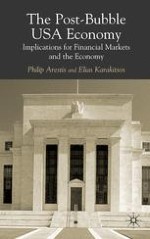2004 | OriginalPaper | Chapter
Long-term Risks to Investment Recovery
Authors : Philip Arestis, Elias Karakitsos
Published in: The Post-Bubble US Economy
Publisher: Palgrave Macmillan UK
Included in: Professional Book Archive
Activate our intelligent search to find suitable subject content or patents.
Select sections of text to find matching patents with Artificial Intelligence. powered by
Select sections of text to find additional relevant content using AI-assisted search. powered by
In the first year of the current recovery investment grew at the worst-ever anaemic pace. Both short- and long-run factors contributed to it. However, in the second half of 2003, following the end of the Iraq war, both the short-run and long-run factors that affect investment have improved. The current accommodating stance of fiscal and monetary policy is probably sufficient for the economy to be booming at the time of the presidential election in November 2004, as there is sufficient momentum already built in. The long-term risk to investment stems from the fact that the current US Administration is not willing to take the risk that the economy would only be growing at the rate of potential output in 2004 as investment growth may be very subdued by then. It is, therefore, considering yet another fiscal package to stimulate the economy in the run up to the presidential election. Although such package would ensure that the economy is booming at the time of the election, it will raise long-term interest rates even more and will foster the forces that would ultimately weaken investment in 2005 and beyond. Hence, the long-term risk to investment would not dissipate by the introduction of yet another fiscal package. Instead, it would increase such risk.
